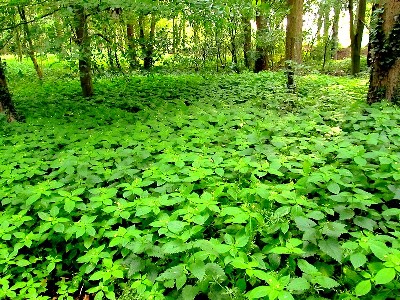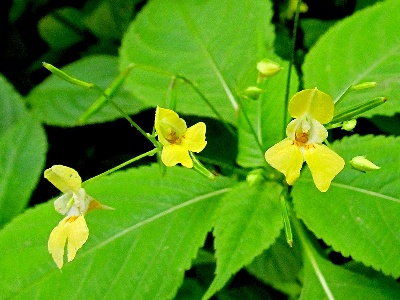Impatiens parviflora DC. (C- and E-Asia) – A commonly naturalised escape from cultivation. First recorded around 1830 in the surroundings of Leuven and soon extending. Initial records were chiefly concentrated in or near gardens, estates, castles and botanical gardens (see also Saintenoy-Simon 2008). Part of the populations are probably introduced unintentionally, for instance with imported timber. At present Impatiens parviflora prevails in the wide vicinity of the larger cities, especially in Flanders (Antwerpen, Brussel, Gent; see Vanhecke 2006).
Impatiens parviflora grows in a wide range of nitrophilous, shady habitats. These are artificial (parks, cemeteries, foot of walls, etc. but also wasteland) as well as natural (woodlands, etc.). Impatiens parviflora often occurs in massive stands, even in nature-like habitats (see also Ćwikliński 1978). But even then it is rarely considered as a noxious environmental weed. Additional information on the potential invasive behaviour of Impatiens parviflora in Belgium and the Netherlands is available at: http://ias.biodiversity.be/species/show/66 and http://www.q-bank.eu/Plants/BioloMICS.aspx?Table=Plants%20-%20Species&Re....
The first Belgian records of Impatiens parviflora (around 1830, see above) possibly represent the earliest on the European continent. According to Galera & Sudnik-Wójcikowska (2010) it was deliberately introduced in Geneva in 1830 from where it was soon further dispersed to other gardens across Europe.


Selected literature:
Adolphi K. (1995) Neophytische Kultur- und Anbaupflanzen als Kulturflüchtlinge des Rheinlandes. Nardus 2: 272 p.
Ćwikliński E. (1978) Die Einwanderung der synanthropen Art Impatiens parviflora DC. in die naturlichen Pflanzengesellschaften. Acta Bot. Slov. Acad. Sci. Slov., A, Taxon. Geobot. 3: 17-34.
Dostálek J. (1997) Spreading of Impatiens parviflora DC. along roads in the territory of the Orlické hory Mts. and their foothills [in Czech]. Příroda 10: 153-157.
Duvigneaud J. (1971) Présence d'Impatiens parviflora dans la région de Charleroi. Nat. Mosana 23(3-4): 107.
Galera H. & Sudnik-Wójcikowska B. (2010) Central European botanic gardens as centres of dispersal of alien plants. Acta Soc. Bot. Polon. 79(2): 147-156.
Jarčuška B., Slezák M., Hrivnák R. & Senko D. (2016) Invasibility of alien Impatiens parviflora in temperate forest understories. Flora 224: 14-23. [available online at: https://www.researchgate.net/publication/304475610_Invasibility_of_alien...
Komosińska E., Wódkiewicz M., Jarzyna I., Jarochowska E., Milanowski R., Chwedorzewska K. & Wyszomirski T. (2006) Some attempts to detect genetic differences between populations of small balsam (Impatiens parviflora DC.). Biodiversity: research and conservation 3-4: 245-247. [available online at: http://www.brc.amu.edu.pl/s2_c2_abstract50.html]
Pohl H. (1992) Quelques observations floristiques effectuées dans le sud de l’Entre- Sambre-et-Meuse. Nat. Mosana 45(2): 68-71.
Saintenoy-Simon J. (ed.) (2008) Trouvailles floristiques récentes (2006-2007. Adoxa 59: 17-51.
Schmitz G. (1991) Nutzung der Neophyten Impatiens glandulifera Royle und Impatiens parviflora DC. durch phytophage Insekten im Raum Bonn. Entomologische Nachrichten und Berichte 35(4): 260-264.
Schmitz G. (1999) Impatiens parviflora D.C. (Balsaminaceae) als Neophyt in mitteleuropäischen Wäldern und Forsten - eine biozönologische Analyse. Zeitschrift für Ökologie und Naturschutz 7: 193-206.
Trepl L. (1980) Über die kleinstandörtliche Verteilung von Impatiens parviflora in einem Eichen-Hainbuchenwald und einem standörtlich entsprechenden Fichtenforst. Decheniana 133: 6-22.
Trepl L. (1984) Über Impatiens parviflora DC. als Agriophyt in Mitteleuropa. Dissert. Bot. 73. Vaduz, J. Cramer: 400 p.
Vanhecke L. (2006) Impatiens parviflora. In: Van Landuyt W., Hoste I., Vanhecke L., Van den Bremt P., Vercruysse W. & De Beer D., Atlas van de flora van Vlaanderen en het Brussels gewest. Instituut voor Natuur- en Bosonderzoek, Nationale Plantentuin van België en Flo.Wer: 492.

